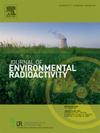Radiocaesium soil-to-plant transfer: a meta-analysis of key variables and data gaps on a global scale
IF 2.1
3区 环境科学与生态学
Q3 ENVIRONMENTAL SCIENCES
引用次数: 0
Abstract
A harmonized, publicly accessible database of worldwide observations and experiments on radiocaesium transfer from soil to plants is lacking. Such a database is needed for evaluating and establishing transfer models, especially for regions with limited research but operational or planned nuclear reactors. Therefore, we systematically screened the literature for radiocaesium soil-to-plant transfer factors (CR, i.e., concentration ratios), extracted data that met the criteria for experimental soundness, relevance, and traceability, and compiled a harmonized database. The database included 7,182 CR data points and associated variables from 139 source documents. The CRs ranged from 0.000028 to 380 kg kg−1, with the highest CR observed with soils from tropical climates and the lowest with soils from temperate climates. However, data from tropical (N = 411) and arid climates (N = 335) remained limited. Univariate and multivariate analyses revealed that CRs were most influenced by the specific study (methods and designs) in which the data were obtained, followed by soil properties and plant species-based categories. On a subset (N = 199) that contained all variables required for semi-mechanistic models, it was found that these models fitted the CR data rather well (R2 = 0.42–0.50). Slightly better predictions with the same data were found with a random forest model (R2 = 0.51) or a statistical mixed-effects model (R2 = 0.58). More adequate machine learning models could not yet be created due to insufficient reliable data. The harmonized database in this study can be further completed and analyzed to support machine learning applications and improve impact assessments of food chain contamination following accidental radiocaesium deposition on agricultural land.

放射性铯从土壤到植物的转移:全球尺度上关键变量和数据缺口的荟萃分析
目前缺乏关于放射性铯从土壤向植物转移的全球观测和实验的统一的、可公开访问的数据库。评价和建立转移模型需要这样一个数据库,特别是对于研究有限但有运行或计划中的核反应堆的地区。因此,我们系统地筛选了放射性铯土壤到植物转移因子(CR,即浓度比)的文献,提取了符合实验合理性、相关性和可追溯性标准的数据,并编制了一个统一的数据库。该数据库包括来自139个源文件的7,182个CR数据点和相关变量。CR范围为0.000028 ~ 380 kg kg−1,热带土壤CR最高,温带土壤CR最低。然而,来自热带(N = 411)和干旱气候(N = 335)的数据仍然有限。单变量和多变量分析显示,cr受获得数据的特定研究(方法和设计)的影响最大,其次是土壤性质和基于物种的植物类别。在包含半机械模型所需的所有变量的子集(N = 199)上,发现这些模型相当好地拟合CR数据(R2 = 0.42-0.50)。随机森林模型(R2 = 0.51)或统计混合效应模型(R2 = 0.58)对相同数据的预测稍好一些。由于可靠数据不足,还无法创建更充分的机器学习模型。本研究的统一数据库可以进一步完善和分析,以支持机器学习应用,并改进农业用地放射性铯意外沉积后食物链污染的影响评估。
本文章由计算机程序翻译,如有差异,请以英文原文为准。
求助全文
约1分钟内获得全文
求助全文
来源期刊

Journal of environmental radioactivity
环境科学-环境科学
CiteScore
4.70
自引率
13.00%
发文量
209
审稿时长
73 days
期刊介绍:
The Journal of Environmental Radioactivity provides a coherent international forum for publication of original research or review papers on any aspect of the occurrence of radioactivity in natural systems.
Relevant subject areas range from applications of environmental radionuclides as mechanistic or timescale tracers of natural processes to assessments of the radioecological or radiological effects of ambient radioactivity. Papers deal with naturally occurring nuclides or with those created and released by man through nuclear weapons manufacture and testing, energy production, fuel-cycle technology, etc. Reports on radioactivity in the oceans, sediments, rivers, lakes, groundwaters, soils, atmosphere and all divisions of the biosphere are welcomed, but these should not simply be of a monitoring nature unless the data are particularly innovative.
 求助内容:
求助内容: 应助结果提醒方式:
应助结果提醒方式:


